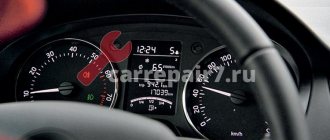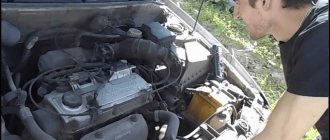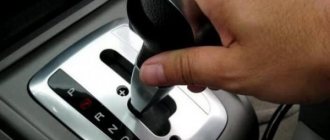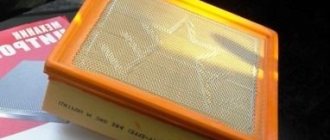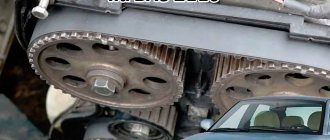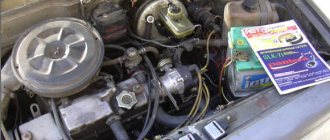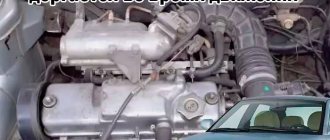During the operation of a car, regardless of the type of engine (gasoline, diesel), displacement, number of cylinders, layout and other features, problems such as: unstable idling, speed floats at idle and/or under load, the engine stalls when pressing brake, etc.
Also, the engine often stalls when the clutch is depressed, which greatly complicates the driving process and can even pose a certain danger. In this article we will talk about why the engine stalls when the clutch is pressed, as well as how to detect and fix such a problem.
Failure when pressing the gas pedal: causes and solutions to the problem
Failure when pressing the gas pedal or accelerator pedal is a problem that is rare in modern cars, but a common occurrence in VAZ cars. The problem is that pressing the pedal has no effect. And after a few seconds there is a jerk, the car jerks. A serviceable engine responds quickly to pressing the gas pedal.
If you find such a problem in your car, do not put off fixing the problem until later. You can diagnose the problem yourself, but the best option would be to contact a car service. Mechanics with extensive experience and modern equipment will quickly find the cause of the gas pedal failure.
In winter, especially on slippery roads, sudden acceleration of the car can turn into a serious problem. In case of loss of control, an emergency situation may occur.
Failure while overtaking a passing vehicle on the road does not bode well. You will have to apply sharp braking and return to your lane, but there may be another car there.
Video “Guide to Replacing the Fuel Filter”
The channel In Sandro's garage, using the example of tenth generation VAZ cars, offers to familiarize yourself with the process of changing the filter device, described in the video.
Do you have any questions? Specialists and readers of the AUTODVIG website will help you ask a question
Was this article helpful?
Thank you for your opinion!
The article was useful. Please share the information with your friends.
Yes (57.14%)
No (42.86%)
X
Please write what is wrong and leave recommendations on the article
Cancel reply
Rate this article: ( 7 votes, average: 4.57 out of 5)
Discuss the article:
What are failures?
Failure when pressing the gas pedal lies in the improper reaction of the engine to this. Thus, when trying to accelerate, the engine does not gain the required speed.
This leads to a drop in speed. It manifests itself with gradual and sudden acceleration. Dips appear when you press the gas pedal in different ways:
- Short-term failures. There is no response to pressing for a couple of seconds.
- Lingering failures. The engine loses speed for 4 to 10 seconds, and it is possible that the car will stall.
- Jerks. Dips up to 1 or 2 seconds. The car seems to be “twitching”.
- A series of jerks. The engine either increases speed or slows down, although the pedal is in the same position.
- The car jerks. Consists of a series of protracted failures.
How does the ECU know when misfires occur?
The ECM may detect misfires differently depending on the vehicle model and engine. The ECU uses many sensors to know when to fire the spark plug, when to inject fuel into the cylinder, and how to change the air-fuel mixture. To detect misfires, the control unit often uses a crankshaft sensor.
Engine ECU
The crankshaft sensor measures the position of the crankshaft and calculates its revolutions per minute. The crankshaft sensor uses the camshaft sensor to determine which cylinder is at top dead center and ready to ignite.
Pushing the pistons down causes a slight increase in crankshaft speed. If the crankshaft sensor does not recognize this increase in speed, the engine control unit will store a fault code on the cylinder on which the misfire occurred.
Sometimes the control unit cannot determine which cylinder is misfiring and it stores the error code P0300 (random misfire).
Some ECUs use ignition coil resistance. When ignition does not occur, the control unit understands this through the electrical wiring, which leads to an error. This method is not as common as detection using the crankshaft sensor.
HAVE YOU FOUND YOUR REASON?
Often, failures occur due to a breakdown of the power system. After pressing the gas pedal, the power system increases the volume of fuel supplied to the cylinders. Breakage causes a change in these proportions. Those. The motor just can't do its job.
In addition, it is possible that there may be a breakdown in the ignition system. It occurs much less frequently. It's either spark plugs or ignition wires. The spark plugs must be removed and checked. The presence of carbon deposits or too clean spark plugs indicate a rich or lean fuel mixture, respectively. This indicates that the ignition system is adjusted incorrectly.
To ensure that the fuel mixture ignites at the right time, read the article on how to set the ignition correctly.
Where is this part located?
It is located on the distributor. If a broken regulator is discovered, replacing the carburetor will not help. Most likely, replacing the regulator will help eliminate the problem.
The next culprit for periodic jerking of the car may be the accelerator pump nozzle. To prevent damage, you should remove the diffusers and, by pressing the lever, evaluate the operation of the pump in each of the chambers. If at least one of them exhibits unstable operation, this is the reason for the VAZ-21124 to twitch when driving. Completely removing the sprayer to clean and ventilate it will help solve this problem. After the procedure, the cleaned part should be installed back. If this was the main reason for the car jerking, then the problem is solved.
Dips when pressing the gas pedal during acceleration
Determined using computer diagnostics or the steps described below:
- The first thing you need to do is inspect the spark plugs. To do this you need to remove them. The presence of carbon deposits on the spark plugs, poor contact with the wires, or an excessively lean or rich mixture lead to spark plug malfunctions.
- High voltage wires can also cause engine malfunction, as can ignition coils.
- The throttle needs to be checked. If it is clogged, this causes the engine to respond untimely when pressing the gas pedal.
- It is necessary to check the condition of the air, fuel and oil filters. They tend to get clogged, which worsens dynamics, increases fuel consumption and causes pedal failure. They need to be changed constantly, you can do it yourself, they are inexpensive and easy to install.
- The presence of errors in the ECU leads to failures.
- Clogged injectors. If necessary, replace or repair injectors.
The wires, as well as the rubber bands on them, should not be damaged and should not spark when the engine is running. If damage is found, this indicates that the engine is shaking and jerking begins. This may occur due to the age of the car, worn-out or low-quality spare parts, poor contact with the spark plugs, or due to the temperature of the engine.
The resistance of the coils and the temperature change together, as a result of which a gasoline car begins to jerk during acceleration. In diesel cars, jerking cannot be associated with the coils, since they are not present.
Is it safe to drive with a misfire?
If a leak occurs, the air-fuel mixture entering the engine will come out unburnt. Modern cars have a catalytic converter that reduces emissions from the car. The catalyst can heat up to 600 degrees during operation.
And what happens when the unburnt air-fuel mixture gets into it? That's right, it will explode inside the catalyst. Explosions inside the catalytic converter can damage it. And a new catalyst is not a cheap pleasure.
In addition, misfires can also damage other sensors in the engine, such as oxygen sensors. We would never recommend driving a vehicle with a misfire, especially over long distances. Short distances to a service station without stress on the engine are normal, but don't ignore gaps and continue driving.
Dips when pressing the gas pedal at idle
Problems also occur at idle speed; of course, there will be fewer reasons. However, this is also a serious problem and cannot be ignored, because... The car will have difficulty starting and simply stall.
Troubleshooting is performed in the following order:
- The first thing to check is the spark plugs. If the spark plugs are faulty, they should be replaced. We recommend replacing all spark plugs at the same time. Buy spark plugs specifically for your engine. If necessary, adjust the gap; it should be 1 mm for 92 gasoline.
- The fuel filter and fuel pump diagnostics are checked. If a malfunction is identified, fix it.
- The breakdown may be in the idle speed sensor.
- Checking the injectors. If clogged, replacement or cleaning is necessary.
- Diagnostics of the ECU for errors.
- Checking the injector.
Dips when pressing the gas pedal - carburetor
As noted above, the problem occurs in VAZ 2107, 2106, 2109 cars that have a carburetor installed. Mainly problems with the fuel system. It will most likely be clogged. Therefore, to identify the cause, the fuel supply to the carburetor is checked.
As a result of clogging, the operation of the fuel pump decreases, and the carburetor begins to receive less fuel. As a result, the engine starts and idles without problems, but when pressed, failures occur.
If everything is fine with the fuel system, then the fault must be looked for in the carburetor. It is responsible for dosing the supplied fuel into the air flow. If there are violations, failure occurs. However, first you need to check for air leaks. The carburetor may become loose, allowing air to leak through the gap, making the mixture lean.
The filter mesh must also be checked. It is located in the inlet fitting of the pipeline that goes to the fuel pump. If it is contaminated, then this is a consequence of failures.
Dips when pressing the gas pedal on the carburetor:
Dips when pressing the gas pedal - injector
To determine the reasons for the failure of the gas pedal of a raspberry with an injection engine, special equipment is needed, with the help of which diagnostics are carried out. Therefore, to detect a malfunction, you should definitely contact a car service in Moscow.
For the most part, jerking occurs when the fuel supply pressure is low or due to problems with the throttle position sensor.
Dismantling
If previous activities have shown that intervention in the design of the ignition switch is required, work in any case will begin with dismantling the device.
We have special step-by-step instructions for this.
- To begin, disconnect the negative terminal from the battery of your VAZ 2110. This way you will ensure your safety and the safety of all wiring. You know what the consequences of a short circuit are.
- Next, remove the casing on the steering column. This is how you gain access to the castle.
- If you feel that the rotary switches will interfere with your work, it is better to remove them immediately. The work does not last for a couple of minutes, so all irritants should be put aside.
- Armed with a chisel and hammer, unscrew the mounting bolts with round heads. Don't get confused, they are the only ones there. Try to perform this operation as carefully as possible so as not to knock off the bolt head.
- Now take the pliers and remove the bolts.
- Insert the key into the ignition and turn it to position zero. This will disable the anti-theft system.
- Next in line is the bracket that held the previously removed bolts and the ignition switch itself.
- Mark the contact wires using different colored markers. Otherwise, you can easily mix them up during reassembly.
- Often it is not necessary to completely replace the lock, but only partial repairs. For example, change the backlight bulb, or fix a microswitch problem.
- Disconnect the connectors that used to operate the ignition switch.
- To replace the backlight bulb, disconnect the corresponding connectors, and then use pliers to remove the bulb.
- To replace the contacts, use a screwdriver to press out the special latches.
- Using a shaped screwdriver, unscrew three screws, after which you can remove the rod.
- Use a regular flathead screwdriver to pry out the clips and remove the microswitch.
- Next, new ones are inserted in place of the dismantled elements.
Checking status
The pedal falls when the car starts to move
All unpleasant sensations are most often associated with a delayed reaction of the motor to pressing the pedal. Engine stalling often occurs.
The shocks appear when the throttle valve opens, then the sensor gives a signal and the ECU determines at what time to switch from idle to load mode, as well as how much to increase the fuel supply through the injectors. If the pressure is not as high as we would like, and if the injection time is increased, then there will not be enough fuel to move the car.
Also, the cause of jerking may be problems with the electromechanical part of the unit and due to clogging with waste.
Conclusion
- Ignition coils and bad spark plugs are the most common problem if you have a misfire.
- Intake leaks are a common problem if you have a trouble code related to the air-fuel mixture.
- If you have an air mixture fault code, always start checking there.
I hope you learned something and solved your misfire problems.
Previous post Idle air control (IAC) - how it works, malfunctions, symptoms, testing
Next entry Error P0339 - what it means, symptoms, causes, diagnosis, solution
The pedal falls when the movement is set
The cause may be a faulty ignition. In this case, diagnostics and repair work are required.
You can try to fix the problem yourself:
- First, you need to look under the hood and inspect everything. Remove the key from the ignition and check whether the ignition coils are securely attached and seated on the spark plugs. Next, start the engine and listen to how it works.
- Replace spark plugs regardless of their condition and how long they last. Check the spark plugs - if they are damaged, engine repair is inevitable.
The gas pedal fails in a VW POLO sedan due to unstable operation of the damper position sensor, which is built into the cover itself. The engine idles intermittently, the engine power is reduced to a minimum - this all indicates that the sensor has failed.
The cover itself cannot be disassembled, so you will have to replace the entire throttle assembly.
Check and diagram of the ignition switch VAZ 2110
The ignition does not turn on on the VAZ 2110? One of the causes of the disease may be in the ignition switch. Don’t rush to replace the ignition switch with a new one, first try checking it yourself.
Malfunctions of the ignition switch VAZ 2110
To determine if the ignition switch is faulty, just check it. Install the key and check the resistance of the contacts with an ohmmeter when switching modes 1, 2, 3 with the key. If the ignition switch is working, then the resistance of the selected contacts should be equal to 0.
VAZ 2110 ignition switch diagram
Ignition switch pinout:
- comes +12V for the microphone of the sensor of the inserted key;
- the mass comes when the driver's door is open;
- +12V goes to the starter (pin 50);
- +12V goes out after turning on the ignition (pin 15);
- +12V goes out when the key is inserted to pin 5 of the BSK;
- comes +12V to illuminate the lock cylinder;
- +12V comes from the battery (pin 30);
- not used.
DON'T POSTPONE YOUR CAR DIAGNOSIS FOR LATER!
If the failures do not stop, then you should definitely contact a specialist. They will be able to diagnose the computer control and check the fuel supply system and determine the location of the breakdown and carry out corrective measures. Most often, the cost of repairs is low. Therefore, the best advice would be not to do it yourself and entrust your car to professionals. This will be the most reasonable decision rather than wasting time, effort and nerves on troubleshooting yourself.
Didn't find the information you are looking for? on our forum.

